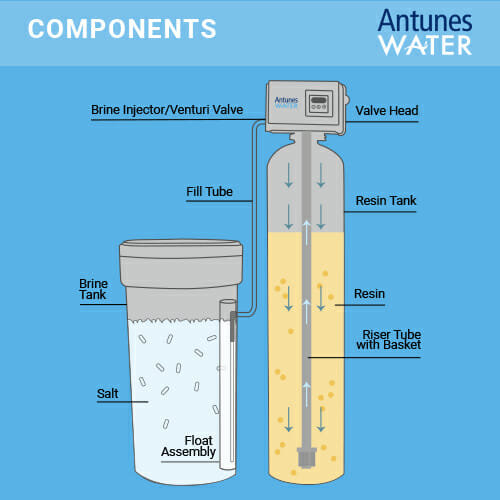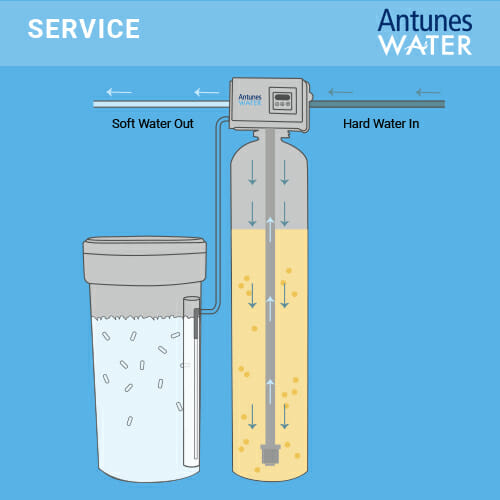Water Softener Treatments: Water Softener Diagram
How does a water softener work? Step by step
What is a water softener?
A water softener is a popular water treatment device. It can be used for many tasks and can be found in various places.
High quality water is useful in many places. People’s homes, hospitals, factories, and schools all need it. It is also needed in many other places.
Water softeners can come in all different shapes, materials, and sizes, depending on what they are being used for. A water softener in someone’s home is typically a cylinder. Its size is usually about 5’1″ ft tall with a 1 ft diameter and your brine tank will sit next to it.
Home water softeners are connected to the water supply. The water for the entire building runs through it.
A water softener is installed to remove minerals from the water. This prevents scale from forming, which can be troublesome.
A water softener is a useful device for a home. This article will explain what it does and how it works. Additionally, we will go over important information to consider when deciding if a water softener is right for you.
What does a water softener do, and who needs one?
You may be asking yourself: what is hard water? How can a liquid be ‘hard’?
The term “hard water” refers to water with high amounts of the dissolved minerals calcium and magnesium. The term originates from the difficulty of washing dishes and clothing with water that has a lot of dissolved minerals. This is harder than using water with less dissolved minerals.
Water with fewer dissolved minerals is called soft water. As the name would imply, a water softener removes the minerals that make water hard, turning it into soft water.
There are many benefits to removing the hardness minerals from your home’s water. Water containing hardness minerals can leave behind a thin, white coating when it comes into contact with surfaces. This is especially true for heated surfaces.
This white coating is often referred to as scale and will grow thicker over time. Scale often builds up around faucets and on the inside of appliances, pipes, and hot water heaters.
Water hardness is not a health hazard. However, it has many other negative effects. Scale build-up is one of them.
As mentioned, hard water will increase the amount of soap and effort needed to clean dishes and clothing. Hard water can leave spots on dishes and clothing. These spots give the appearance of dirt, even if the items were just cleaned.
Hard water can cause scale to build up in pipes and appliances. This can lead to reduced water flow, or even complete clogs.
Scale accumulates inside your water heater. This reduces efficiency and increases costs for gas or electricity. Scale is notoriously difficult to clean, and often requires the use of specialized chemicals to completely eliminate it.
Luckily, all of these problems can be solved with one piece of equipment: a water softener. Just about anyone can benefit from having a water softener installed in their home. Families who own homes in areas with high water hardness will experience the most significant improvement in water quality.
Some areas of the country with particularly high hardness are the Midwest, the Great Plains, the Southwest, and Florida. Anyone who draws water from a private well is likely to have high levels of hardness. This is because private wells are more prone to water hardness.
Components of a Water Softener

The Antunes Water Whole House Water Softening System includes the following components: Control Valve, Bypass Valve, Distributor Baskert, Yoke, Power Supply, Drain Elbow, Brine Tubing, Brine Tank Lid, Pressure Tank, Brine Tubing, Brine Tank and Brine Tank Valve.
How does a Water Softener Work Step by Step:
Water Softener Diagram

The Water softener system diagram displays how the Antunes Water Whole House Water Softening System reduces hardness in the water. Our water softening systems provide soft water to every area of the home. This process is illustrated in the flow diagram.
Most water softener systems have three main components. The components of a water softener are resin tank, the control valve head, and the brine tank.
The control valve head is typically attached to the top of the resin tank.
The brine tank usually sits next to the resin tank. It is connected to the resin tank by tubing. However, some consumer softener systems are designed with the brine tank and resin tank self-contained. While this is might seem convenient, these types of systems are typically less robust and have more maintenance problems. They are also usually throw-away systems, i.e. if something goes wrong then you need to purchase an brand new one instead of just a new part because they are not as durable.
Water normally flows into the softener through the control valve head’s inlet. It then moves downward into the resin tank, as shown in the water softener diagram. As water flows through the resin tank, it must pass through the ion exchange resin within the tank.
These small beads exchange the calcium and magnesium minerals in the water for sodium, effectively softening the water. The water flows up a tube in the center of the tank. It then passes through the control valve head. Finally, it exits the system through the outlet.
Another important function of the softener is the regeneration cycle. While the softener is an amazing piece of technology, no system is perfect.
Hardness minerals are removed from the water. This causes the resin in the tank to reach its capacity limit. Once it reaches this limit, it will no longer be able to remove additional hardness. At this point, the resin must regenerate so that the softener can continue to function as intended.
The regeneration cycle consists of several stages, but the most important of these is the brine draw stage. Brine is drawn from the brine tank. It is drawn into the softener. This replaces the sodium lost in the softening process.
This is why the brine tank is necessary and must be connected to the softener at all times. Luckily, a softener’s regeneration cycle is programmed to take place at night. This is when water usage is less likely.
What do I need to know when buying a water softener?
Be aware when buying a softener. Make sure it meets your needs. Research different products to find the right one. The first, and maybe most obvious thing to consider, is how large of a softener you are going to need.
As a rule, a 1 cubic foot softener is sufficient for households with two people or one person. This will provide enough capacity. If your household has three or more inhabitants, it is recommended to choose a larger two cubic foot water softener. This will provide better results.
Choose a location for the softener with enough floor space. This space should accommodate both the resin tank and the brine tank. Additionally, the location chosen must be within 6 feet of a standard 120V electrical outlet.
Finally, because the softener requires a drain line, it must be relatively close to a drain. Check the softener’s manual to determine what the maximum regeneration flow rate will be for your model of softener.
Water softeners are generally considered to be low-maintenance. However, there are some factors to consider before buying one. Make sure to take these into account before making your purchase. The most important ongoing task for water softener maintenance is to make sure the brine tank remains filled with salt.
The amount of salt consumed by the water softener will vary. This is based on the size of the softener and the amount of water used daily. However, it is recommended that the brine tank be checked weekly and refilled with salt as necessary.
It is recommended that the brine tank be cleaned once a year. This helps to remove impurities that may have come with the salt. This prevents the buildup of substances in the tank. Additionally, it should be refilled with salt.
Remember that the resin in the resin tank has a lifespan of 8 years. It needs to be replaced after this time. Home water softeners usually need to have the entire tank replaced after a certain period of time.
The sturdiest water softeners have resin tanks made from fiberglass, and user-programmable control valves made with metal. Make sure to look for the NSF certification when purchasing a water softener. An NSF certification means that the softener went through rigorous testing to ensure that it’s capable of reliably reducing the hardness in water below one grain per gallon. Only the best water softeners are available with an NSF certification should be considered for your home.
A water softener is a simple yet very effective water treatment device that can bring benefits to any home that has hardness in its water. Water softeners can prevent headaches caused by scale and can protect your entire home.
When purchasing a softener, the most important things to consider are the size of the system, where it will go in your home, and how much salt you are going to need to keep it running. Now that you know all about water softeners, you will be informed on your future purchase.
Antunes offers several different sizes of residential water softeners for sale. Our water softener systems are made with the highest quality fiberglass tanks and control valve heads and are, of course, NSF certified.
Get the Antunes Water Whole House Water Softening System and benefit from having soft water in your home!


 Antunes Green Solution Spotlight: VZN-541VE Ultrafiltration System
Antunes Green Solution Spotlight: VZN-541VE Ultrafiltration System